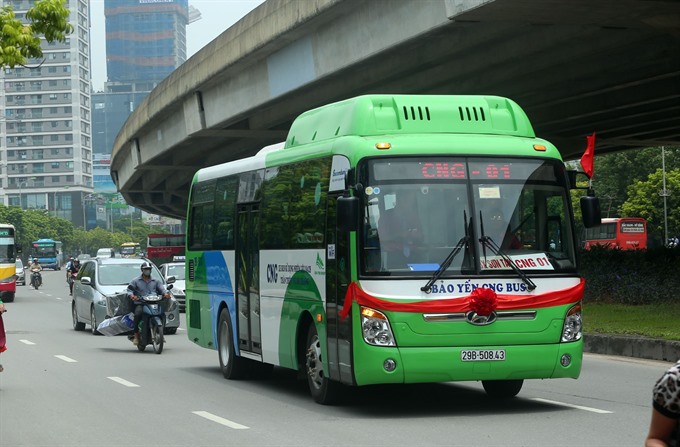 Society
Society

Only 1.7 per cent of the total credit account outstanding for the national economy in 2017 is provided for green finance by public and private banks.
 |
| CNG buses are a part of Hà Nội’s green growth action plan. - VNA/VNS Photo Huy Hùng |
HÀ NỘI – Only 1.7 per cent of the total credit account outstanding for the national economy in 2017 is provided for green finance by public and private banks.
The percentage remained low despite the sharp growth at 29.4 per cent between 2016 and 2017.
The findings was presented on Friday at a meeting entitled “Coordination of green growth efforts and closing of the project in strengthening capacity and institutional reform for green growth and sustainable development in Việt Nam”.
It was hosted by the Ministry of Planning and Investment (MPI), United Nations Development Programme (UNDP) and US Agency for International Development (USAID).
The “National Strategy on Green Growth for the period of 2011-2020 with the vision to 2050,” commonly known as Việt Nam’s Green Growth Strategy or VGGS, was first introduced in 2012.
Green growth was defined by VGGS as the most efficient approach to accelerate reduced greenhouse gasses along with promoting the economy’s competitiveness.
Since then, Quảng Ninh Province, Lâm Đồng Province’s Đà Lạt City, Hà Nam Province, HCM City, Cao Bằng Province, Bắc Kạn Province and Hà Nội had developed their own green growth action plans, said Nguyễn Tuấn Anh, deputy director of Department for Science, Education, Natural Resources and Environment under MPI.
Hà Nội has shown its strong commitment in managing waste, setting up rooftop solar panels on public building and using CNG eco-friendly buses.
Domestic policy instruments and official development assistance (ODA) have created favourable conditions to increase investments in energy efficiency and renewable energy generation.
Việt Nam also played an active role in pursuing the Clean Development Mechanism (CDM).
According to the Private Climate Expenditure and Envestment Review of Việt Nam, 255 projects registered CDM, however, as the market for Certified Emission Reductions (CERs) collapsed, almost no CDM projects are presently being developed.
The lack of interest of local companies in investing in clean energy-related projects as well as difficulties of the domestic intermediary banking institutions limit potentials of ODA loans and credit offers by international financial institutions in developing new energy efficiency and renewable energy projects.
Experts expressed their hopes of opening up opportunities for public-private partnerships for low carbon development and promoting private investment in the Mekong Delta.
Scott C. Bartos, Environment Team Lead of the Environment and Social Development Office under USAID, stressed upon the cooperation of the government, private sector and international organisations in striving to reduce GHG, improving environment and achieve the Sustainable Development Goals by 2030.
“After three years working in Việt Nam, I have learnt the importance of having agencies at different levels engaging in and communicating (to solve problems). One cannot be successful without others,” he said.
“The government cannot clear a path without understanding sector by sector and source by source to find solutions for green growth and emission mitigation.” – VNS




